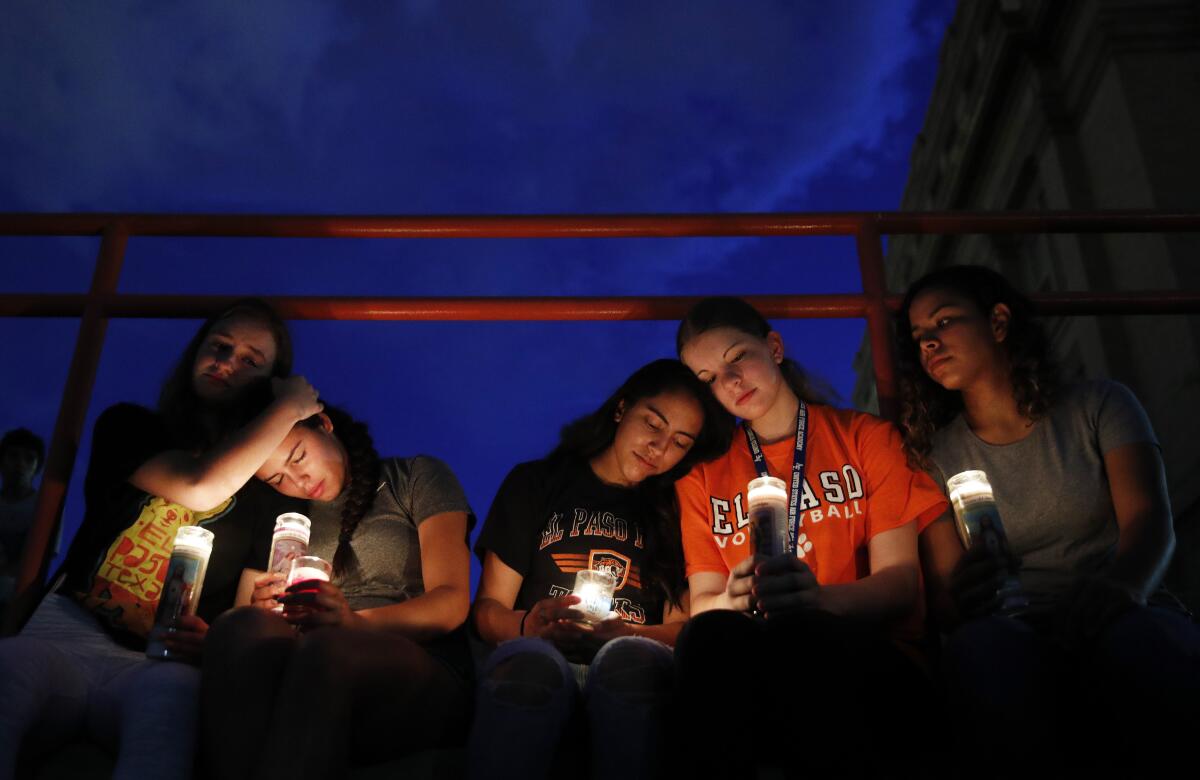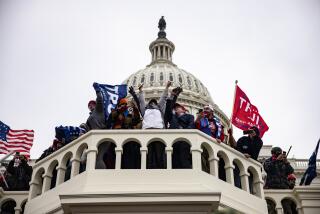For our kids, the white guy with a gun is the face of terrorism

- Share via
My children don’t remember 9/11. My youngest hadn’t yet been born; her siblings were 3 years old and 17 months old. They know what that date signifies, have seen the footage and visited the site, but they don’t know what it means — not really. They cannot fathom the devastating cultural dislocation that occurred in those moments when the World Trade Center collapsed, the Pentagon burned and the seemingly impossible became real.
My children do not believe in the seemingly impossible. In a country where mass shootings have become routine, nothing seems impossible.
For them, the symbol of terror and terrorism is not Osama bin Laden, or even ISIS. For them, the symbol of terror and terrorism is a fellow American — almost always a man, almost always white — shooting a bunch of people he does not know. In a theater, a school, an office. At a mall, a concert, a restaurant, a festival, a Walmart.
These events do not shock them or wrench their belief about American culture from its socket. Mass shootings are part of what they know to be American culture. And the fact that no one seems to care enough to do anything to prevent them.
Yes, many protest and march and write outraged think pieces like this one. But since the ban on assault weapons expired in 2004, any attempt to prevent mass shootings, or even curtail their increasing frequency and deadliness, has been largely a matter of rhetoric.
If you can call statements on Twitter rhetoric.
For better and worse, the United States did plenty of things to prevent another 9/11. In addition to the military actions, agencies were established, a commission was formed, formal inquiries were made by the FBI and Congress, victim compensation acts were passed, additional security measures were taken at government buildings and, of course, airports.
After this weekend’s twin massacres in El Paso, Texas, and Dayton, Ohio, most government officials responded with what many young people deride as “thoughts and prayers” tweets or equally familiar calls for increased gun control.
My children do not wonder what meaningful actions will be taken to address our country’s acceptance of mass shootings as a way of life. They wonder when it will be their turn to either run, duck or fall.
Not if.
When.
I have spent years giving them advice about what to do when a shooter appears in their classroom/club/store/church, most of which involves being aware of, and never far from, the exits — and remembering that while you can get hurt jumping through a window to safety, it probably won’t kill you like a bullet will.
Advice that is probably useless.
I, meanwhile, end virtually every day with the prayer that when the shooter comes, it is to the place I am, rather than where my children are. Though the odds of family members dying in two separate incidents are becoming shorter every day.
It is to the credit of our government’s post- 9/11 response that my children, who do not remember a time when you could take a full-sized tube of toothpaste on an airplane, are not afraid of bombs.
Instead, thanks in very great part to that same government, they are afraid of ... I was about to write guns, but that is not true.
My kids are not afraid of “guns.” They are afraid of assault weapons. And before some of you start sending me comments about how the media doesn’t know the difference between automatic and semiautomatic, I am going to go with the Justice Department’s definition: “semiautomatic firearms with a large magazine of ammunition that were designed and configured for rapid fire and combat use.”
You know, the ones that were banned until 2004.
This is the part where lots of people say that mass shootings have increased 200 percent since the ban expired, and lots of people say that it’s not true. Or that Neil DeGrasse Tyson points out, for reasons of his own, that lots of people die from the flu too.
This is the part where people start yelling about mental health and Mitch McConnell and the 2nd Amendment and video games and everyone gets real comfortable in their corners, all decorated with opposing graphs and anecdotal evidence and definitions of what it means to be American.
And while we’re all doing that, someone somewhere is wondering when it would be a good idea to go to your local school/grocery store/library/amusement park and shoot as many people as he can before the police get to him.
Not if.
When.
This is not new and this is not normal and we have to stop talking past each other and do something about it.
We should absolutely be concerned about mental health, security, and even violence in popular culture. But since guns are what allow a crazy person to become a mass murderer, that something will have to involve the control of guns.
President Trump recently said he supported legislation that would encourage states to implement “red flag” laws to make it easier to ensure that people with certain mental illnesses cannot purchase guns, and that’s something.
Former attorney general Eric Holder and many others have called for a federal ban on assault weapons, silencers and body armor as well as universal background checks.
Many police officers have called for stricter and more strictly enforced laws regarding illegal gun possession, or, as the failed Gun Violence Prevention and Safe Communities Act of 2018 proposed, that certain weapons and ammunition be subject to taxation.
A call to make purchasing a gun as difficult as it is to seek an abortion — “a mandatory 48-hour waiting period, written permission from a parent or a judge, a note from a doctor proving that he understands what he is about to do, time spent watching a video on individual and mass murders, traveling hundreds of miles at his own expense to the nearest gun shop” — has even been making the rounds.
Is there a perfect solution that will end all mass shootings? No, but all or nothing is not the standard of law. Some or all of these suggestions might not solve the problem, but separately or together they would certainly help.
You know what won’t help? Doing what we’ve been doing. Which is nothing.
By doing nothing, we not only accept the increased regularity of mass shootings, we condone it. By doing nothing, we tell the world that it’s fine for armed men to kill large numbers of Americans.
Doing nothing says the pleasure some people take in owning a certain type of weapon is more important than the fear the rest of us have for our safety. Some people take pleasure in driving while intoxicated, but that isn’t legal. Not all — maybe not even most — drunk drivers kill people. But some do, and we as a society aren’t willing to take the chance.
Doing something, on the other hand, lets the world know, and our kids know, that the American government is actually in the business of protecting its citizenry from threats alien and domestic, that our war on terrorism is real and universal.
That at the very least we believe the threat of death by mass shooting should be an “if,” not a “when.”
More to Read
The biggest entertainment stories
Get our big stories about Hollywood, film, television, music, arts, culture and more right in your inbox as soon as they publish.
You may occasionally receive promotional content from the Los Angeles Times.











